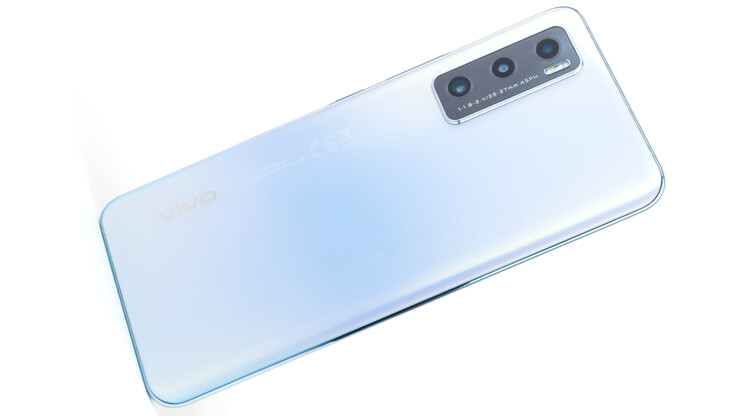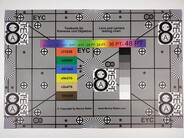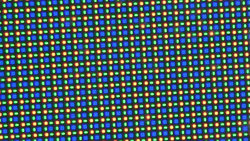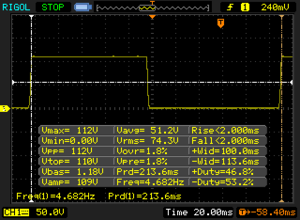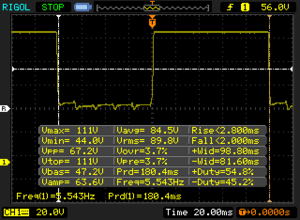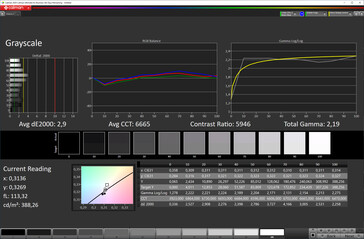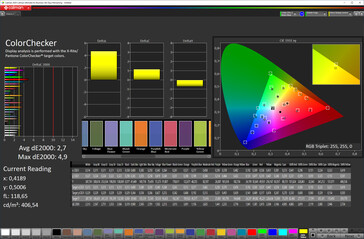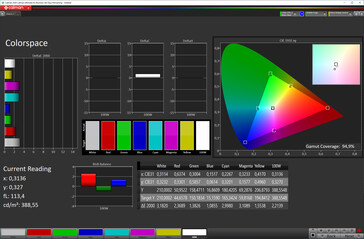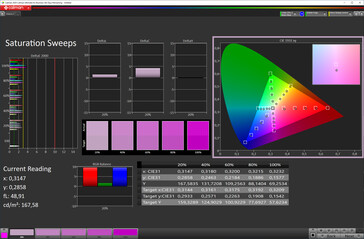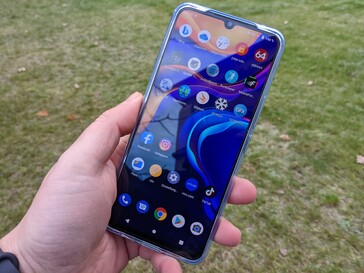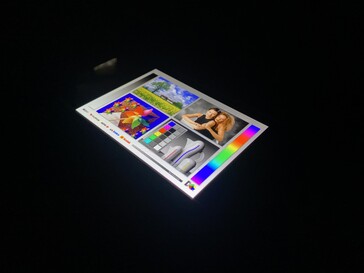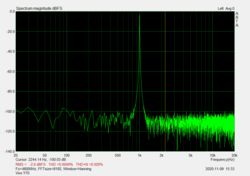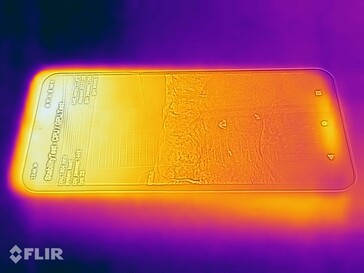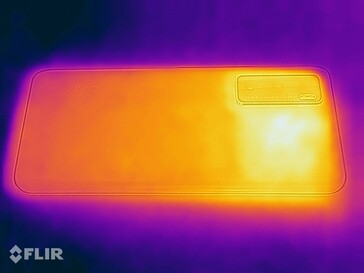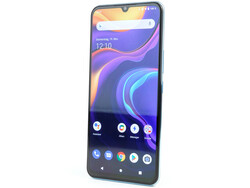Vivo Y70 smartphone Review - Lots of memory and battery power in a slim design
Possible competitors in comparison
Bewertung | Rating Version | Datum | Modell | Gewicht | Laufwerk | Groesse | Aufloesung | Preis ab |
|---|---|---|---|---|---|---|---|---|
| 79.9 % | 7 | 01/2021 | Vivo Y70 SD 665, Adreno 610 | 171 g | 128 GB UFS 2.0 Flash | 6.44" | 2400x1080 | |
| 82.9 % | 7 | 08/2020 | Xiaomi Mi Note 10 Lite SD 730G, Adreno 618 | 204 g | 64 GB UFS 2.0 Flash | 6.47" | 2340x1080 | |
| 79.4 % | 7 | 11/2020 | Samsung Galaxy M31s Exynos 9611, Mali-G72 MP3 | 203 g | 128 GB UFS 2.1 Flash | 6.50" | 2400x1080 | |
| 80.2 % | 7 | 08/2020 | ZTE Axon 11 Helio P70, Mali-G72 MP3 | 165 g | 128 GB eMMC Flash | 6.47" | 2340x1080 |
Case, equipment and operation
The Vivo Y70 is available in Oxygen Blue and Gravity Black, the latter being our review sample. The casing is completely made of plastic on the outside, but it still looks high-quality and fits very well in the hand due to its low weight and slim build of 7.83 millimeters. The gaps are mostly tight, only the transition between the back and the frame is not even in all places when looking closely
The Y70's extensive UFS storage can additionally be expanded via microSD card, but it does not support the exFAT file system and cannot be formatted as internal storage. The USB 2.0 port supports OTG and an audio jack is integrated, but there is no FM receiver
Our review sample was shipped with Google Android 10 and Funtouch OS, but the update to Android 11 was rolled out during the test. Vivo also promises software support and security updates for four years for the Y70.
The Wi-Fi module of Vivo's smartphone supports Wi-Fi 5 (IEEE 802.11 a/b/g/n/ac) and provides a decent speed and high stability of the connection in combination with our reference router Netgear Nighthawk AX12. The smartphone accesses the data network via LTE at best and offers decent frequency coverage, which is absolutely sufficient for inner-European use
During a phone call, the Vivo Y70 user's voice is rendered clearly and with low noise as long as there are no persistent, loud interfering noises. In such a case, these are muffled, but the speaker is then also transmitted quite muffled and short interruptions can occur. If we switch to the speakerphone, we can already hear a hall in the immediate vicinity of the Y70. If we move further away from the smartphone, we can hardly be understood from one meter. The Vivo phone offers a full dual-SIM solution and supports VoLTE as well as Wi-Fi calling
Both a fingerprint scanner integrated into the display and 2D facial recognition are available for biometric security. The former responds quite reliably, but not always very quickly
| Networking | |
| iperf3 transmit AX12 | |
| Xiaomi Mi Note 10 Lite | |
| Vivo Y70 | |
| ZTE Axon 11 | |
| Samsung Galaxy M31s | |
| iperf3 receive AX12 | |
| Vivo Y70 | |
| Xiaomi Mi Note 10 Lite | |
| Samsung Galaxy M31s | |
| ZTE Axon 11 | |
Cameras - Vivo Y70 with 48 MP optics
The front-facing camera of the Vivo Y70 enables appealing pictures in good lighting conditions and also has a portrait mode with adjustable blur. It is also possible to be inspired by fade-in poses, which are sorted by subject. Videos are recorded in 1,080p with 30 FPS at best
The main camera enables decent photos and also copes well with backlit subjects. Zooming is only possible digitally and up to a maximum of ten times magnification. The sensor quickly reaches its limits in dark environments, but it also has a night mode on board. The app offers a Pro mode, among other things, and also allows the full use of the 48 MP, which are otherwise added to 12 MP with pixel binning
Videos can be recorded in Ultra HD (30 FPS) or Full HD (30 and 60 FPS)
Image Comparison
Choose a scene and navigate within the first image. One click changes the position on touchscreens. One click on the zoomed-in image opens the original in a new window. The first image shows the scaled photograph of the test device.
WeitwinkelWeitwinkelZoom (5-fach)Low-Light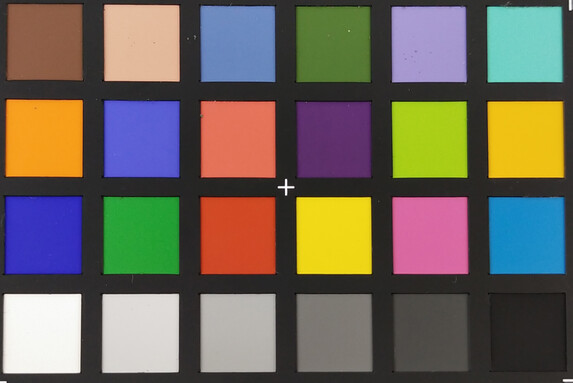

Display - AMOLED in the Vivo smartphone
The 6.44-inch (16.36 cm) AMOLED panel of the Vivo Y70 offers a high pixel density and a correspondingly sharp display. The brightness achieves a good and very evenly distributed luminosity with a full-screen white reproduction. It is even up to 746 cd/m² in the APL50 measurement. If you adjust the brightness manually, you only have 387 cd/m² available. The panel is also certified for HDR10 playback
The measurement with the oscilloscope shows typical OLED flickering; the Y70 does not have a DC dimming mode. The color reproduction is quite cool in the factory settings. Users who want a natural reproduction should switch to the Normal profile in the settings, which only uses the smaller sRGB color space instead of DCI-P3
| |||||||||||||||||||||||||
Brightness Distribution: 97 %
Center on Battery: 573 cd/m²
Contrast: ∞:1 (Black: 0 cd/m²)
ΔE Color 2.7 | 0.5-29.43 Ø5
ΔE Greyscale 2.9 | 0.57-98 Ø5.3
94.9% sRGB (Calman 2D)
Gamma: 2.19
| Vivo Y70 AMOLED, 2400x1080, 6.44 | Xiaomi Mi Note 10 Lite AMOLED, 2340x1080, 6.47 | Samsung Galaxy M31s Super AMOLED, 2400x1080, 6.50 | ZTE Axon 11 AMOLED, 2340x1080, 6.47 | |
|---|---|---|---|---|
| Response Times | -79% | -86% | 10% | |
| Response Time Grey 50% / Grey 80% * | 4.8 ? | 10 ? -108% | 10 ? -108% | 4 ? 17% |
| Response Time Black / White * | 4 ? | 8 ? -100% | 8 ? -100% | 3.6 ? 10% |
| PWM Frequency | 245.1 ? | 176.1 -28% | 125 -49% | 250 ? 2% |
| Screen | 33% | -2% | -26% | |
| Brightness middle | 573 | 605 6% | 584 2% | 610 6% |
| Brightness | 572 | 608 6% | 586 2% | 614 7% |
| Brightness Distribution | 97 | 95 -2% | 95 -2% | 98 1% |
| Black Level * | ||||
| Colorchecker dE 2000 * | 2.7 | 0.84 69% | 2.09 23% | 4.8 -78% |
| Colorchecker dE 2000 max. * | 4.9 | 1.8 63% | 7.96 -62% | 7.7 -57% |
| Greyscale dE 2000 * | 2.9 | 1.3 55% | 2.2 24% | 3.9 -34% |
| Gamma | 2.19 100% | 2.211 100% | 2.084 106% | 2.21 100% |
| CCT | 6665 98% | 6310 103% | 6512 100% | 7122 91% |
| Total Average (Program / Settings) | -23% /
-4% | -44% /
-30% | -8% /
-14% |
* ... smaller is better
Display Response Times
| ↔ Response Time Black to White | ||
|---|---|---|
| 4 ms ... rise ↗ and fall ↘ combined | ↗ 2 ms rise | |
| ↘ 2 ms fall | ||
| The screen shows very fast response rates in our tests and should be very well suited for fast-paced gaming. In comparison, all tested devices range from 0.1 (minimum) to 240 (maximum) ms. » 11 % of all devices are better. This means that the measured response time is better than the average of all tested devices (21.5 ms). | ||
| ↔ Response Time 50% Grey to 80% Grey | ||
| 4.8 ms ... rise ↗ and fall ↘ combined | ↗ 2.8 ms rise | |
| ↘ 2 ms fall | ||
| The screen shows very fast response rates in our tests and should be very well suited for fast-paced gaming. In comparison, all tested devices range from 0.2 (minimum) to 636 (maximum) ms. » 11 % of all devices are better. This means that the measured response time is better than the average of all tested devices (33.7 ms). | ||
Screen Flickering / PWM (Pulse-Width Modulation)
| Screen flickering / PWM detected | 245.1 Hz | ≤ 99 % brightness setting | |
The display backlight flickers at 245.1 Hz (worst case, e.g., utilizing PWM) Flickering detected at a brightness setting of 99 % and below. There should be no flickering or PWM above this brightness setting. The frequency of 245.1 Hz is relatively low, so sensitive users will likely notice flickering and experience eyestrain at the stated brightness setting and below. In comparison: 53 % of all tested devices do not use PWM to dim the display. If PWM was detected, an average of 17924 (minimum: 5 - maximum: 3846000) Hz was measured. | |||
Performance, emissions and battery life
The Vivo Y70 is equipped with a Qualcomm Snapdragon 665 with 8 GB of working memory, which ensures a good system performance in everyday use. The integrated Adreno 610 is one of the weaker GPUs and demanding games will not be rendered in full details. It is positive that Vivo uses fast UFS storage, which is far superior to conventional eMMC storage even in the older 2.0 version used here. However, the microSD slot only shows slow read and write rates in combination with our reference card Toshiba Exceria Pro M501
The surface temperatures remain harmless at all times and the SoC is not negatively affected by high load either. The mono speaker on the bottom edge is one of the better ones of its kind, but sounds a bit hollow at high volumes. The audio jack is convincing and shows a very good signal-to-noise ratio
The 4,100 mAh battery provides the Vivo Y70 with good battery runtimes. The smartphone can be fully recharged in less than two hours with the included 33-watt power adapter
| PCMark for Android - Work 2.0 performance score (sort by value) | |
| Vivo Y70 | |
| Xiaomi Mi Note 10 Lite | |
| Samsung Galaxy M31s | |
| ZTE Axon 11 | |
| Average Qualcomm Snapdragon 665 (6189 - 11432, n=12) | |
| Average of class Smartphone (9101 - 12871, n=4, last 2 years) | |
| GFXBench | |
| on screen Aztec Ruins Normal Tier Onscreen (sort by value) | |
| Vivo Y70 | |
| Xiaomi Mi Note 10 Lite | |
| Samsung Galaxy M31s | |
| ZTE Axon 11 | |
| Average Qualcomm Snapdragon 665 (6.2 - 15, n=12) | |
| Average of class Smartphone (3.6 - 123, n=224, last 2 years) | |
| 1920x1080 Aztec Ruins Normal Tier Offscreen (sort by value) | |
| Vivo Y70 | |
| Xiaomi Mi Note 10 Lite | |
| Samsung Galaxy M31s | |
| ZTE Axon 11 | |
| Average Qualcomm Snapdragon 665 (7.8 - 8.4, n=12) | |
| Average of class Smartphone (2.3 - 229, n=224, last 2 years) | |
| on screen Aztec Ruins High Tier Onscreen (sort by value) | |
| Vivo Y70 | |
| Xiaomi Mi Note 10 Lite | |
| Samsung Galaxy M31s | |
| ZTE Axon 11 | |
| Average Qualcomm Snapdragon 665 (3.9 - 9.1, n=12) | |
| Average of class Smartphone (2.8 - 105, n=224, last 2 years) | |
| 2560x1440 Aztec Ruins High Tier Offscreen (sort by value) | |
| Vivo Y70 | |
| Xiaomi Mi Note 10 Lite | |
| Samsung Galaxy M31s | |
| ZTE Axon 11 | |
| Average Qualcomm Snapdragon 665 (2.7 - 2.8, n=12) | |
| Average of class Smartphone (0.85 - 94, n=224, last 2 years) | |
| Vivo Y70 | Xiaomi Mi Note 10 Lite | Samsung Galaxy M31s | ZTE Axon 11 | Average 128 GB UFS 2.0 Flash | Average of class Smartphone | |
|---|---|---|---|---|---|---|
| AndroBench 3-5 | -9% | 19% | 1% | 9% | 184% | |
| Sequential Read 256KB | 509 | 501 -2% | 490.3 -4% | 309.9 -39% | 530 ? 4% | 1505 ? 196% |
| Sequential Write 256KB | 218.5 | 213.2 -2% | 318.4 46% | 257.9 18% | 215 ? -2% | 1112 ? 409% |
| Random Read 4KB | 149.5 | 134.6 -10% | 105 -30% | 81.2 -46% | 129.6 ? -13% | 247 ? 65% |
| Random Write 4KB | 164.3 | 125.8 -23% | 117.1 -29% | 29.32 -82% | 100.7 ? -39% | 271 ? 65% |
| Sequential Read 256KB SDCard | 43.11 ? | 73.6 ? 71% | 78.9 ? 83% | 68.3 ? 58% | ||
| Sequential Write 256KB SDCard | 37.03 ? | 59.9 ? 62% | 62.6 ? 69% | 53.2 ? 44% |
Temperature
(+) The maximum temperature on the upper side is 30.5 °C / 87 F, compared to the average of 35 °C / 95 F, ranging from 21.9 to 56 °C for the class Smartphone.
(+) The bottom heats up to a maximum of 30.3 °C / 87 F, compared to the average of 33.8 °C / 93 F
(+) In idle usage, the average temperature for the upper side is 23.5 °C / 74 F, compared to the device average of 32.7 °C / 91 F.
Loudspeaker
Vivo Y70 audio analysis
(+) | speakers can play relatively loud (93.5 dB)
Bass 100 - 315 Hz
(-) | nearly no bass - on average 24% lower than median
(+) | bass is linear (3.3% delta to prev. frequency)
Mids 400 - 2000 Hz
(±) | reduced mids - on average 8.7% lower than median
(+) | mids are linear (6.7% delta to prev. frequency)
Highs 2 - 16 kHz
(+) | balanced highs - only 4.2% away from median
(+) | highs are linear (5.7% delta to prev. frequency)
Overall 100 - 16.000 Hz
(±) | linearity of overall sound is average (18.6% difference to median)
Compared to same class
» 15% of all tested devices in this class were better, 8% similar, 76% worse
» The best had a delta of 12%, average was 38%, worst was 134%
Compared to all devices tested
» 37% of all tested devices were better, 8% similar, 56% worse
» The best had a delta of 4%, average was 25%, worst was 134%
Samsung Galaxy M31s audio analysis
(+) | speakers can play relatively loud (82.7 dB)
Bass 100 - 315 Hz
(-) | nearly no bass - on average 67.9% lower than median
(+) | bass is linear (0% delta to prev. frequency)
Mids 400 - 2000 Hz
(-) | nearly no mids - on average 67.9% lower than median
(+) | mids are linear (0% delta to prev. frequency)
Highs 2 - 16 kHz
(-) | nearly no highs - on average 67.9% lower than median
(+) | highs are linear (0% delta to prev. frequency)
Overall 100 - 16.000 Hz
(-) | overall sound is not linear (117.4% difference to median)
Compared to same class
» 85% of all tested devices in this class were better, 8% similar, 7% worse
» The best had a delta of 12%, average was 38%, worst was 134%
Compared to all devices tested
» 95% of all tested devices were better, 2% similar, 2% worse
» The best had a delta of 4%, average was 25%, worst was 134%
Battery life
| Vivo Y70 4100 mAh | Xiaomi Mi Note 10 Lite 5260 mAh | Samsung Galaxy M31s 6000 mAh | ZTE Axon 11 4000 mAh | Average of class Smartphone | |
|---|---|---|---|---|---|
| Battery Runtime | |||||
| WiFi Websurfing | 819 | 1095 34% | 1309 60% | 606 -26% | 913 ? 11% |
Pros
Cons
Verdict - Good start in the midrange
Vivo's Y70 is a good mid-range smartphone that primarily stands out from the crowd with its long update promise of four years. It has a good OLED screen, a fast system performance, and above all a lot of storage space. The voice quality and battery runtimes are also convincing in the test
The Vivo Y70 is a good mid-range smartphone that is technically convincing for the most part, but has shortcomings in the microSD slot and the cameras
Small compromises have to be made with the triple camera. While the main sensor enables decent pictures, the two additional lenses are without real added value in everyday use. Furthermore, the microSD card slot is comparatively slow and does not support exFAT. It is also positive that Vivo provides the buyer with a suitable fast charger
Price and availability
The Vivo Y70 is offered in both colors at MediaMarkt and Saturn for 299 Euros, among others.
Vivo Y70
-
08/31/2022 v7
Daniel Schmidt


 Deutsch
Deutsch English
English Español
Español Français
Français Italiano
Italiano Nederlands
Nederlands Polski
Polski Português
Português Русский
Русский Türkçe
Türkçe Svenska
Svenska Chinese
Chinese Magyar
Magyar